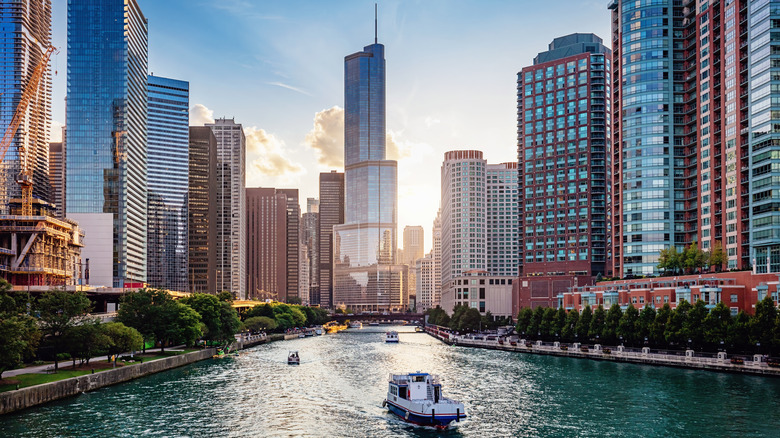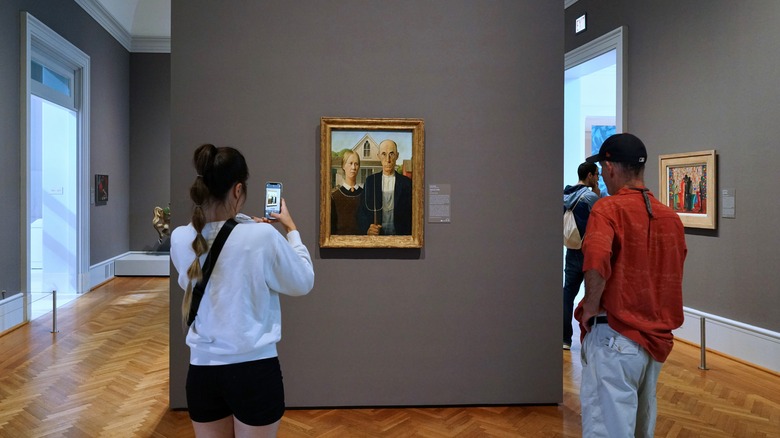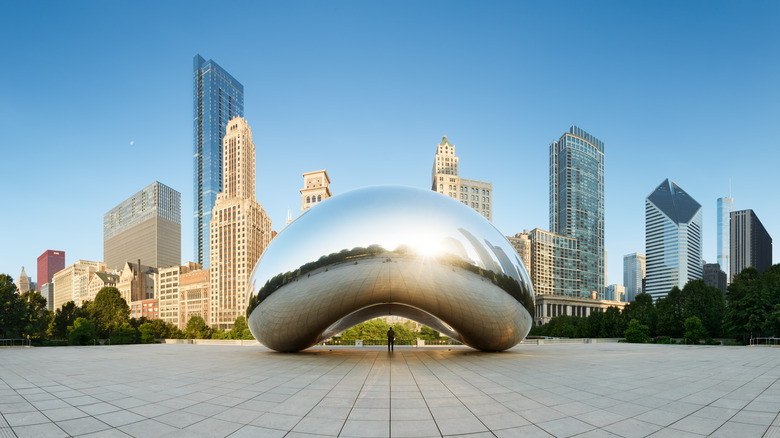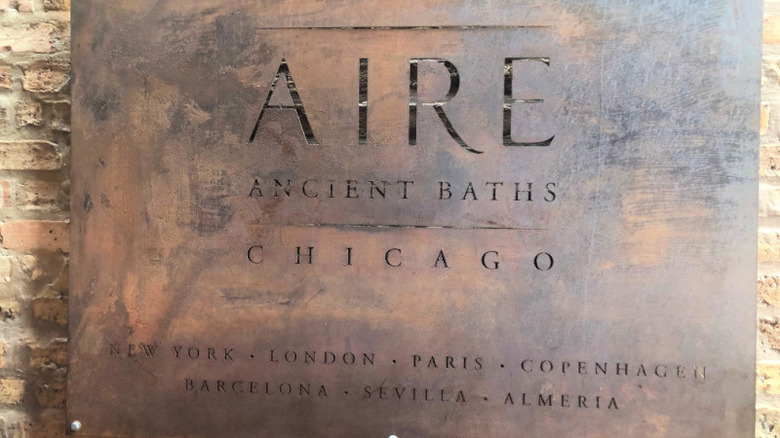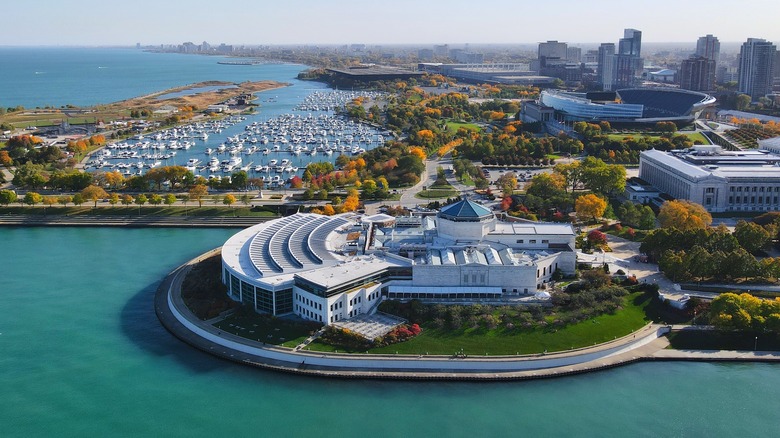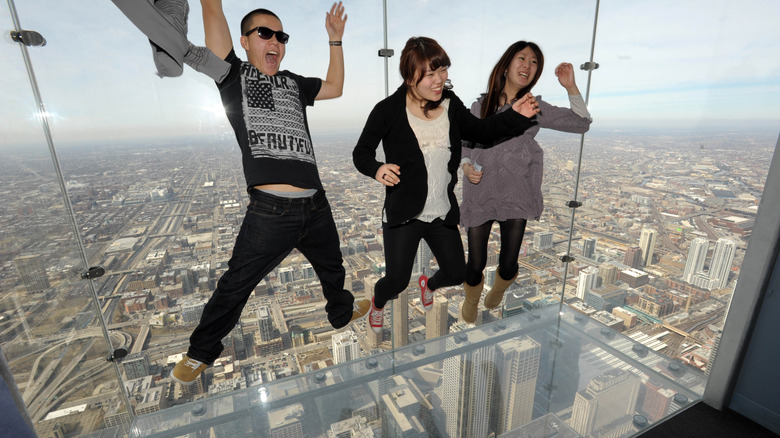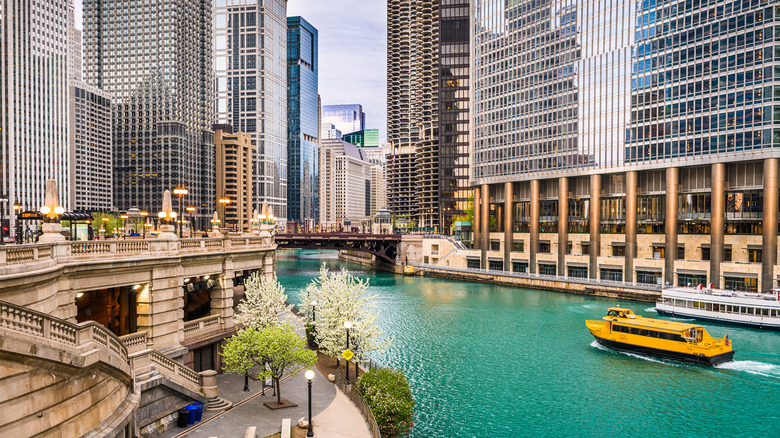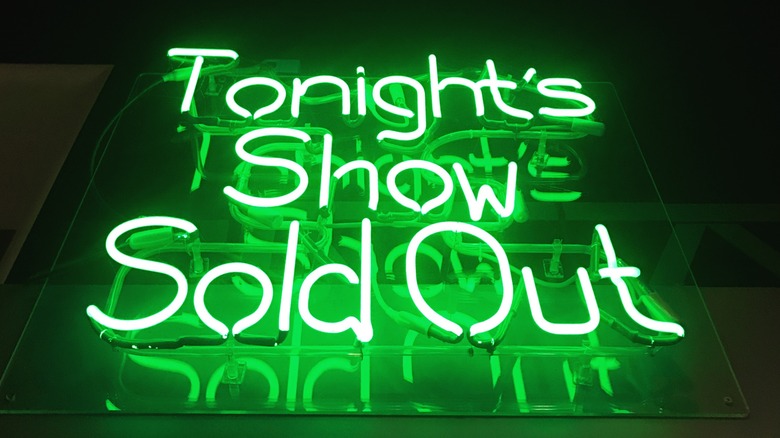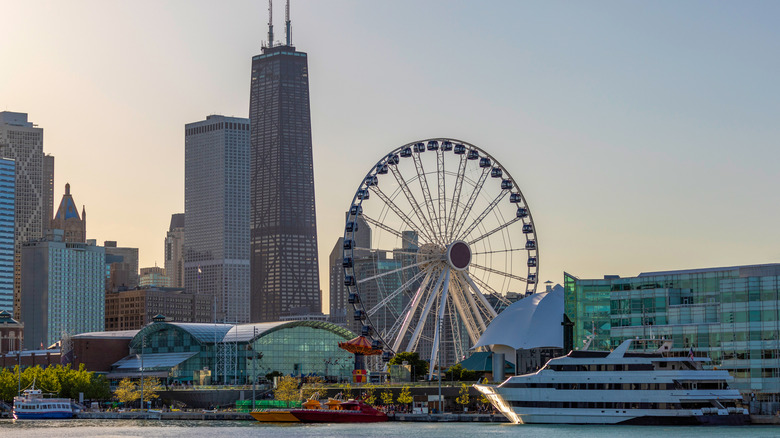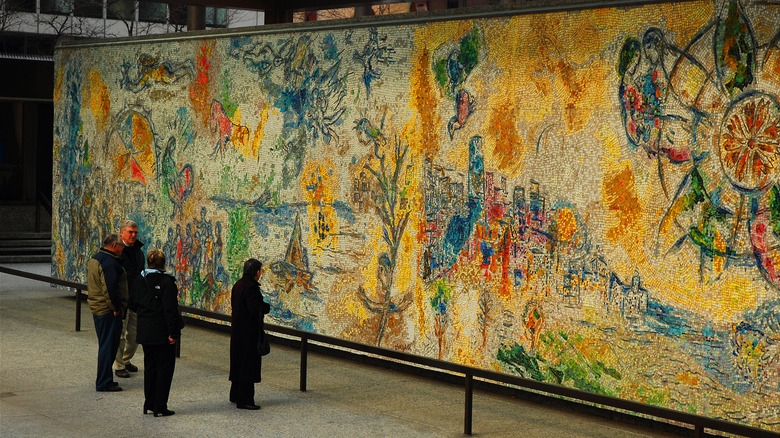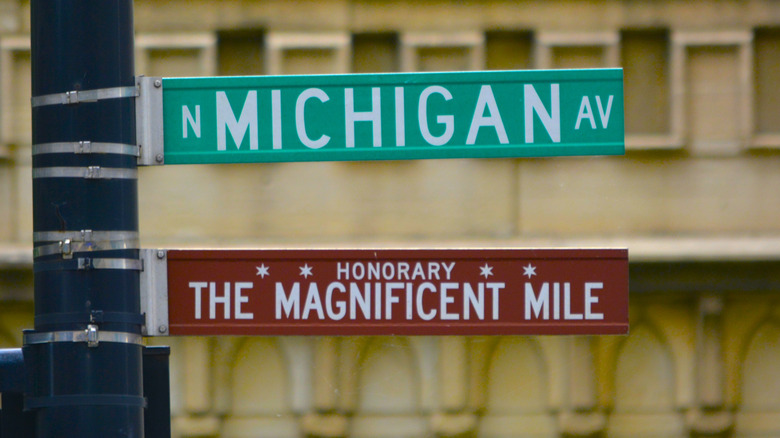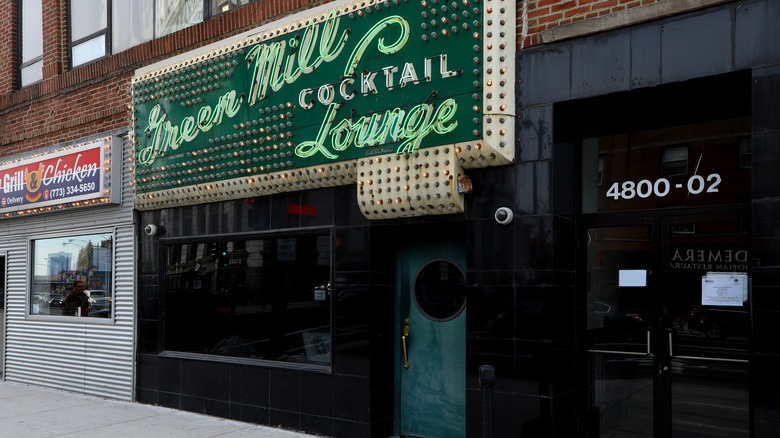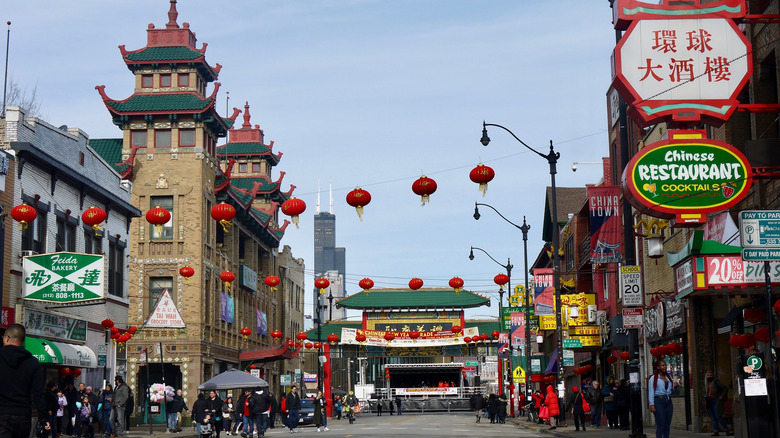The Best Places For A Day Trip If You're Staying In Chicago
Chicago is the shining gem of the Midwest, a popular destination for business and leisure travelers alike. Nicknamed the Windy City because of the air currents whipping off Lake Michigan, Chicago is truly a destination for all seasons. From the blooming gardens in the spring to the summer music festivals and the vibrant fall colors to the winter getaway activities, Chicago is bustling with activities year-round.
If you have a day free while staying in Chicago, there is an embarrassment of riches to fill your itinerary. The city is home to some of the nation's finest museums, the streets are filled with art and music, and there are incomparable shopping experiences. Participate in some of Chicago's most iconic experiences, stroll through its parks, or even relax with a communal bathing experience. Chicago has it all, and your biggest regret may be that you don't have enough time to experience it all. Combining the recommendations of Choose Chicago (the city's official tourism website), the opinions of other travelers, and our own extensive experiences in the country's third-largest city, we've curated a list that combines famous and lesser-known experiences of how to spend the perfect day in the Windy City.
Absorb art at the Art Institute of Chicago
You can't claim to know Chicago until you've spent a day at the Art Institute of Chicago. Since its opening in 1879, the institute has become an icon of the city, frequently marked as the top thing to do in town. Originally part of the city's efforts to rebuild after the Great Fire of 1871, it moved to its current home in the heart of downtown in 1893 as part of the World's Columbian Exposition, complete with the famous lion sculptures standing guard at the entrance. Whether you prefer modern art, Renaissance classics, or Impressionist masterpieces, you can find a wing in this museum to excite your senses. The work of some of the most famous artists in the world resides in their halls, including names like Monet, Renoir, Dalí, Picasso, and Van Gogh. In recent years, the institute has made a concerted effort to expand and diversify its collections and exhibitions, including more magnificent indigenous, Black, and female art.
The museum offers multiple tours, and its website provides suggestions on how to experience the collections, whether you have an hour or a day. Some visitors to the museum even set out to recreate Ferris Bueller's famous visit in the iconic 1986 movie. There are many ways to make the most of your visit to this pride of the Windy City attraction.
Visit the Bean in Millennium Park
Millennium Park was a favorite destination for photographers long before Instagram took over the world. Home to the iconic Bean sculpture (officially known as Cloud Gate), the urban park has gardens, sculptures, an ice rink, and a packed calendar of entertainment and events. While the modern-day park began taking shape in 1998, its roots go back to 1844 when the land it was on was designated parkland. However, in 1852, the City of Chicago gave some of the land to the railroad companies, which was reclaimed in a lawsuit in 1996. Now dubbed Millennium Park, it attracts tourists from around the world and provides an escape for residents searching for ways to while away the day.
In 2006, British-Indian sculptor Anish Kapoor created Cloud Gate, the 33-foot high, 42-foot wide, 66-foot long, and 110-ton steel sculpture. It reflects the city's skyscape and is one of the world's largest permanent outdoor art installations. Elsewhere in the park, the Crown Fountain, designed by Jaume Plensa, uses water, light, and glass to create an urban playground ripe for splashing during the summer. Rather than gargoyles, the fountain is bookended with "Faces of Chicago," two 50-foot towers that project rotating portraits of 1,000 Chicago residents. Other features of the park include the Jay Pritzker Pavilion, Lurie Garden, Boeing Galleries, Millennium Monument at Wrigley Square, and Harris Theater for Music and Dance.
Experience ancient Roman baths
If you are searching for an oasis of serenity amid the bustle of the Windy City, head down to the renowned Aire Ancient Baths Chicago. One of only two in the U.S. (the other is in New York), this international bath house is in a restored factory in the River West downtown neighborhood. Step inside the 1902-constructed building, where exposed bricks, wooden beams, and columns evoke a bygone era before you move into the communal bathing area. The area is dimly lit with flickering candles and the quiet hum of running water from the six thermal baths, two aromatherapy steam rooms, and one indoor-outdoor pool with a waterfall.
Outside the communal bathing area, you can indulge in experiences from a wine bath for two, a massage, or a hydration ritual using crystals and sandalwood oil. Unlike some baths in the city, bathing suits are mandatory in the communal areas, and each guest is provided with a robe in the luxurious, modern locker rooms. Pool names evoke the Roman experience with Latin monikers that describe their uses, such as the saltwater Flotarium, the hot 102 degrees Fahrenheit Caldarium, or the Balneum, a bath of a thousand jets. In one area, you can scrub yourself with salt to exfoliate before showering. Drinking water is available throughout. End your experience resting in the deep-cushioned couches of the lounge, enjoying offerings from their juice menu.
Explore Chicago's most famous museums
To truly do Chicago museums justice, you need more than a day. With over 70 museums, Chicago offers visitors many varied places to learn more about anything and everything. The best museums to visit in Chicago cover an incredible range of interests, and here are a few to get you started. The city's oldest museum, founded in 1857, is the Chicago Academy of Sciences. In 1894, it moved to Lincoln Park, where it is now known as the Chicago Academy of Sciences/Peggy Notebaert Nature Museum. The Field Museum is home to the largest dinosaur ever discovered, while the Shedd Aquarium has more than 32,000 creatures and is one of the largest aquariums in the world. When it opened in 1930, Adler Planetarium was the first planetarium in the Western Hemisphere, while the Museum of Science and Industry in Hyde Park is housed in a building built for the 1893 World Expo.
While those are the most famous museums, Chicago's streets are filled with museums targeting more narrow interests. If you want something more niche, consider the American Writers Museum, the Museum of Illusions, the International Museum of Surgical Science, the Frank Lloyd Wright Home and Studio, the Ernest Hemingway Birthplace Museum, the Busy Beaver Button Museum, or the Medieval Torture Museum. If you dare, of course.
Get a bird's-eye view of the city
With the opening of the Sears Tower in 1973, Chicago earned bragging rights to the world's tallest building, an honor it held until 1996. No trip to Chicago is complete without a trip up its elevators to the 103rd floor (the building has 110 floors in total), where visitors take in a breathtaking 360-degree view of the city. In 2009, Willis Towers Watson took over the tower, and the newly named Willis Tower continues to attract visitors to the SkyDeck, where it is possible to see four states from the lofty platform.
The Willis Company set about transforming the tower, including adding The Ledge, a glass box extending 4.3 feet from the Skydeck, 1,353 feet in the air. While visiting, you can participate in the SkyDeck Experience, an interactive show exploring Chicago's history with simulated views of the city's attractions. For those who want to take in the sunset, Willis Tower staff recommend arriving 35-40 minutes before sundown and buying your timed access ticket in advance. If you're not sure you can get the shot you want, professional photographers are available for hire. If you're taking kids, join in on the interactive activities, scavenger hunts, and coloring activities designed for the younger set.
Cruise through downtown architecture
Chicago is an architectural playground, home to the works of famous architects through the years, including luminaries such as Frank Lloyd Wright and Ludwig Mies van der Rohe. It's a place where builders come to experiment, and the rest of the world shows up to admire their achievements. From skyscrapers to churches and parks to piers, each building in the city tells a story. Walking the streets, you might see an Art Deco building next to another in Moorish Revival style, where architectural styles dot the landscape representing modernism, Venetian Gothic, Italian Renaissance, and much more.
There is so much to see that many turn to the experts to be able to take it all in. A great place to start is the Chicago Architecture Center, where the museum is enhanced with a walking, bus, L-train, or boat tour. Boat tours include those along the coast on Lake Michigan or ones meandering through the city on the Chicago River. Select the tour that best matches your interests, whether it is a general tour that catches the highlights, a tour that takes you to glass and mosaic installations all designed by Tiffany Glass Company, tours of Chicago's Golden Age (1890 through 1930), art deco skyscrapers, pub tours or the underground Pedway system. Turn to independent providers, and you can even catch a tour with Chicago's brick whisperer, who will share the story behind Chicago's most basic building block.
Laugh yourself silly with improv comedy
Live theater thrives in Chicago, whether it is the large shows in the historic establishments of the Theater District, the modern works of Steppenwolf, or the storefront theaters dotting each neighborhood. It's where actors hone their trade, creating and workshopping some of the world's most original theater. In the 1950s, a small troupe started what would become an international phenomenon — The Second City. Now synonymous with improv, the company has since opened locations in Toronto and New York. Through the years, it has hosted touring companies and television shows and sent work to Broadway. Some of the stars who have gotten their start with The Second City include Alan Alda, Bill Murray, Gilda Radner, John Belushi, Dan Aykroyd, Tina Fey, Stephen Colbert, and Chris Farley.
In Chicago, The Second City performs in seven theaters at two locations, each offering its own style of comedy, from improv musicals to movie parodies to mystery shows. You can start your day with one of their brunch shows and end it with a late-night comedy. It is also home to world-renowned classes in improv, with both a dedicated school and drop-in classes for people who want to experiment and try their hand at making audiences laugh.
Peruse the Pier
With its iconic Centennial Wheel and weekly fireworks throughout the summer, the 3,300-foot-long Navy Pier is a favorite destination for families. Jutting out on Lake Michigan, it is home to the Chicago Children's Museum, the Chicago Shakespeare Theater, and a historic carousel. Constructed in 1916 as a shipping and recreational facility, it has been a destination for millions, and today's pier is an authentic Chicago experience for tourists and locals alike.
Navy Pier has a mix of free and ticketed attractions, something designed to keep it accessible for all, and a way for families on a budget to enjoy a day out celebrating some of the best Chicago has to offer. Entrance to Navy Pier itself is free. Visitors are greeted by the massive Polk Brothers Fountain and Plaza Park. From there, guests can wander the sites, eat at the many restaurants, ride the multiple carnival-type attractions, get lost in a fun home maze, imbibe at a beer garden, and listen to live music. It is the launching pad for many of Chicago's water taxis, water cruises, and dinner cruises. You can even rent a room at Sable at Navy Pier and not have to leave when the sun goes down.
Stroll through iconic street art
Chicago's streets are filled with art. Some pieces are famous, such as Picasso's unnamed 50-foot tall sculpture and Chagall's "The Four Seasons," while others come and go on the sides of buildings or in temporary outdoor exhibitions. Each of Chicago's 77 community areas has its own vibe, and most have thriving art scenes, street art, graffiti, or stunning murals and sculptures. Whether it is the trendy art scene of River North or the 20 large-scale murals of the Wabash Arts Corridor, the Windy City wants you to stop and take notice.
Loop Chicago offers a free self-guided Loop Mural Walk with three different routes wandering by some of the city's iconic artworks, while the Pilsen neighborhood is a hub of Mexican culture where the mural movement is alive and well. Head over to Bucktown to see the beloved "Greetings from Chicago" mural. New York artists Lisa Beggs and Victor Ving have achieved fame for their series of "Greetings From" murals in nearly 30 cities across the country, but Chicago came first.
Shop 'til you drop on the Magnificent Mile
People from all over the Midwest make pilgrimages to Chicago for day-long shopping trips, and most spend at least some time on the Magnificent Mile, a place often referred to as one of the most iconic shopping areas in the world. The Magnificent Mile is filled with everything from department stores to malls and shopping centers. There are luxury labels and locally owned brands. Children frolic at stores such as the American Girl Place and Lego while fashionistas get their groove on at Levi's, Patagonia, or ZARA. If you want to buy it, you'll probably find it on the Magnificent Mile.
The Magnificent Mile is home to Water Tower Place, a Chicago landmark that is a 758,000-square-foot shopping mall in a 74-story skyscraper. Seven floors are devoted to the mall and its more than 60 stores, while other floors house offices, condominiums, a live Broadway in Chicago theater, many restaurants, and the Ritz Carlton hotel. Travel to the eighth floor, where you can eat at Harry Caray's 7th Inning Stretch and visit the Chicago Sports Museum.
Groove to jazz and blues
Since the 1940s, Chicago's streets have thrummed to the sounds of jazz and blues, with some of the city's most famous musicians revolutionizing the musical landscape. Entire subgenres of blues and jazz are named for the city, like Chicago-style jazz, a thrilling stew of styles that cranks everything up to 11 with throbbing bass and quicker tempos. Meanwhile, Southern Black migrants introduced the city to the blues, a genre that evolved when it came into contact with the urban culture up north, creating an amplified sound known as Chicago Blues. The city comes to life yearly with the Blues Festival in June and the Jazz Festival in July. Both are free. Both are magnificent.
In 1947, Joe Segal opened The Jazz Showcase, and its stage has hosted major names like Dizzy Gillespie, Ira Sullivan, and Count Basie. The Green Mill Cocktail Lounge was a favorite speakeasy of Al Capone during Prohibition, and some claim he still haunts the place. Blues guitarist Buddy Guy opened Buddy Guy's Legends, which hosts well-known musicians year-round. The Grammy-award-winning singer still performs there annually, and it is a mecca for Chicago blues lovers. The oldest continuously running blues club in Lincoln Park is Kingston Mines, which was founded in 1968. It features two stages where bands alternate sets and the music plays until the early hours of the morning.
Taste the architecture and food of the Far East
Chinatown is a neighborhood on the south side of Chicago where Chinese culture is lived and celebrated. According to the Encyclopedia of Chicago, nearly one-third of Chicago's Chinese residents live there, making it one of the largest concentrations of Chinese Americans in the United States. Formed around 1912 when the Chinese population moved south from The Loop, today it fills 30 blocks with more than 400 businesses and 27,000 residents. The historic neighborhood is filled with landmarks and attractions, many with distinct Chinese architecture. The Pui Tak Center is a community center with a pagoda-style entrance and an ornate roof. The Nine Dragon Wall near the entrance to Chinatown showcases nine large dragons and more than 500 smaller ones. In Chinatown Square, you can search for your zodiac sign on the statues before strolling through the Ping Tom Memorial Park on the Chicago River. It is filled with Chinese murals, dragon poles, a pavilion, and a red zigzag bridge.
Everyone will tell you to arrive in Chinatown hungry. Start your day with milk tea and breakfast pastries at one of the many bakeries. Have a dim sum lunch or visit one of the ramen noodle shops for your midday meal. For dinner, decide whether you want to indulge in pan-Asian fusion food, Szechuan hotpot, or Chinese soup dumplings. There are even late-night Hong Kong-style cafeterias.
